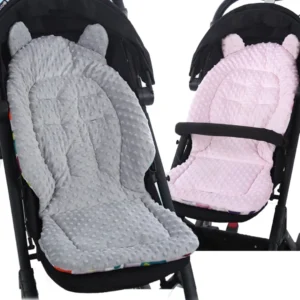Have you ever wondered when your little bundle of joy can finally sit in a stroller and enjoy the wonders of the world around them?
Well, the answer might surprise you!
Around the magical age of 6 months, when infants have developed good head and neck control, they can happily ride in a stroller.
But hold your excitement, because there’s more to it than meets the eye.
Before you hit the pavement, let’s dive into all the important details and safety guidelines that come along with this exciting milestone.
Get ready for a whole new level of stroller adventures!
when can infant sit in stroller
Infants can generally start sitting in a stroller around 6 months of age when they have developed enough muscle strength and coordination.
However, it is important to consult with your pediatrician to determine the right time for your specific infant.
Some strollers offer reclining positions that are suitable for younger infants who are not yet able to sit upright.
It is also important to ensure that the stroller provides proper support for the infant’s head and neck to avoid any potential injuries.
Always follow the manufacturer’s guidelines and recommendations for your particular stroller model, and supervise your infant while they are in the stroller to ensure their safety.
Key Points:
- Infants can start sitting in a stroller around 6 months when they have developed muscle strength and coordination.
- Consult your pediatrician to determine the appropriate time for your specific infant.
- Some strollers offer reclining positions suitable for younger infants who cannot sit upright.
- Ensure the stroller provides proper support for the infant’s head and neck to prevent injuries.
- Always follow the manufacturer’s guidelines and recommendations for your stroller model.
- Supervise your infant while they are in the stroller to ensure their safety.
Check this out:
💡 Did You Know?
1. In some cases, infants can start sitting in a stroller as early as three months old, as long as their neck muscles are strong enough to support their head.
2. Strollers were initially designed for wealthy families in Europe during the 19th century. They were seen as a status symbol and were often pushed by servants.
3. The world’s largest stroller parade occurred in South Carolina, USA, in 2015, with 1,058 participants pushing their strollers simultaneously.
4. Strollers were initially called “perambulators” in the 1800s, and they were mainly used to transport sick or invalid infants.
5. It wasn’t until the early 1900s that strollers featured adjustable seats, which allowed infants to recline instead of sitting upright, expanding their comfort and safety.
Developmental Milestones And Physical Capabilities
As a parent, one of the many exciting milestones you look forward to is when your infant can sit up in a stroller and enjoy the world around them. However, it’s important to remember that every child develops at their own pace. The ability to sit in a stroller depends on their developmental milestones and physical capabilities.
At around 6 months of age, most infants have developed the necessary muscle strength and coordination to sit in a stroller comfortably. However, a crucial prerequisite is their ability to hold their head steady and have good head and neck control. Infants need to be able to support their own head and neck to sit upright in a stroller without any discomfort or risk of injury.
It’s essential to observe your infant’s progress and ensure they have achieved these milestones before transitioning them to a stroller. This ensures their safety, comfort, and overall enjoyment of the strolling experience.
- Infants need to hold their head steady and have good head and neck control before sitting in a stroller.
- Most infants can sit in a stroller comfortably around 6 months of age.
- Observing your infant’s progress is important before transitioning them to a stroller.
“Every child develops at their own pace.”
Recommended Age For Stroller Use
Although the general recommendation for infants to start using a stroller is around 6 months of age, it is important to remember that every child is unique. Some infants may reach the required developmental milestones earlier, while others may take a little longer.
Consulting with your pediatrician is crucial in determining the appropriate age for your specific infant to sit in a stroller. Your pediatrician can evaluate your child’s physical development and provide personalized guidance to ensure their safety and comfort. They may also consider any individual factors that could impact your child’s ability to sit in a stroller, such as prematurity or physical conditions.
Always take your pediatrician’s recommendations into account when deciding when to introduce a stroller to your infant. They are well-equipped to evaluate your child’s unique situation and provide the most accurate advice.
- Every child is unique, and the recommended age to start using a stroller is around 6 months.
- Consulting with your pediatrician is crucial to determine the appropriate age for your specific infant.
- Your pediatrician can evaluate your child’s physical development and provide personalized guidance.
- Individual factors like prematurity or physical conditions should be considered.
- Always follow your pediatrician’s recommendations for the safest and most accurate advice.
Consult With Pediatrician
When it comes to your child’s health and safety, consulting with a pediatrician before introducing them to a stroller is essential. Pediatricians have a deep understanding of child development and can offer expert advice on when it’s appropriate for your infant to sit in a stroller.
Their guidance can help you make an informed decision based on your child’s specific needs and capabilities. They can assess your infant’s physical development, evaluate their muscle strength and coordination, and provide personalized recommendations for stroller use.
It is important to avoid making assumptions or comparing your child’s development to others. Each child grows and develops at their own pace, so seeking professional guidance is key to ensuring the well-being and safety of your infant.
Here are some key points to remember:
- Consult a pediatrician before introducing your child to a stroller.
- Pediatricians have expert knowledge about child development.
- Assess your infant’s physical development and muscle strength and coordination.
- Personalized recommendations for stroller use can be provided.
- Every child grows at their own pace; avoid comparisons.
“Seeking professional guidance is key to ensuring the well-being and safety of your infant.”
Reclining Positions For Younger Infants
Safety should be the top priority when it comes to using a stroller for your infant. Many strollers on the market offer reclining positions specifically designed for younger infants who are not yet able to sit upright independently.
If your infant is below the age or lacks the necessary muscle strength to sit up in a stroller, consider a stroller with these reclining features. These positions provide adequate support for your infant’s head, neck, and overall body posture. This helps prevent any strain or discomfort while ensuring their safety during stroller rides.
Reclining positions are designed to mimic the familiar lying-down posture of younger infants and can be adjusted as your child grows and develops the ability to sit independently. Always refer to the manufacturer’s instructions and guidelines to ensure you are using the stroller correctly and providing the appropriate support for your infant.
Follow Manufacturer’s Guidelines And Recommendations
When it comes to the safety, comfort, and appropriate use of a stroller, it is crucial to follow the manufacturer’s guidelines and recommendations. Strollers come in various designs and models, each with specific features and usage instructions.
Read the instruction manual thoroughly and understand the proper way to use your particular stroller model. Pay close attention to the recommended age and capabilities for stroller use. The manufacturer’s guidelines will provide important details about the stroller’s safety features, harnesses, and how to ensure proper support for your infant’s head and neck.
Ignoring or disregarding the manufacturer’s guidelines can compromise the safety and well-being of your child. Taking the time to familiarize yourself with the instructions will give you peace of mind knowing that you are using the stroller correctly and providing the best possible experience for your infant.
Support, Comfort, And Safety Considerations
When selecting a stroller for your infant, it is crucial to prioritize their support, comfort, and overall safety. These considerations play a significant role in ensuring a positive stroller experience and avoiding any potential injuries or discomfort.
Choose a stroller that provides proper support, especially for your infant’s head and neck. Look for models with cushioned headrests, adjustable harness systems, and sturdy frames that provide stability and comfort during stroller rides.
Consider the safety features of the stroller, such as a five-point harness system that securely holds your infant in place. Ensure the stroller has a reliable braking system, sturdy wheels, and a wide base to prevent tipping or instability.
Keep in mind that each infant is unique, and their preference for strollers may vary. Some infants may prefer baby carriers or slings during the first few months before transitioning to a stroller. Taking your infant’s comfort and preferences into account will create a more enjoyable experience for both of you.
Always supervise your infant while they are in a stroller and avoid rough terrains or uneven surfaces to prevent accidents or injuries. Regularly inspect the stroller for wear and tear, and keep it clean and free from any potential hazards.
- Ensure proper supervision of your infant while in the stroller.
- Avoid rough terrains or uneven surfaces to prevent accidents or injuries.
- Regularly inspect the stroller for wear and tear.
- Keep the stroller clean and free from any potential hazards.
Conclusion
The appropriate age for an infant to sit in a stroller depends on their developmental milestones and physical capabilities, particularly their ability to hold their head steady and have good head and neck control.
While the general recommendation is around 6 months of age, consulting with your pediatrician is vital to determine the right time for your individual infant.
Additionally, following the manufacturer’s guidelines, providing proper support, and prioritizing safety and comfort are essential to ensure an enjoyable stroller experience for both you and your infant.
- Consult with your pediatrician to determine the appropriate age for your infant to sit in a stroller.
- Ensure your infant has good head and neck control before using a stroller.
- Follow the manufacturer’s guidelines for stroller usage.
- Provide proper support to ensure your infant’s safety and comfort while in the stroller.
Note: It is important to prioritize safety and comfort to ensure an enjoyable stroller experience.
FAQ
When can I put my baby in the stroller without car seat?
The transition from using a car seat to a stroller without one typically occurs when your baby has developed the ability to sit up unaided, typically around 6 months of age. Although every baby reaches this milestone at different times, it is an indication that they possess the necessary strength and stability to sit comfortably in a stroller without the car seat. However, it is important to remember that each child’s development is unique, so observing their individual readiness for this transition will ensure their safety and comfort while enjoying stroller rides.
Can a 2 month old sit in an umbrella stroller?
No, it is not recommended for a 2-month-old to sit in an umbrella stroller. Most umbrella strollers are specifically designed for babies who are 6 months or older and can sit up on their own. At 2 months, babies are still developing their neck and back muscles, making them unable to support themselves in an upright sitting position. It is essential to prioritize the safety and comfort of the baby by using strollers specifically designed for their age and developmental stage.
Can a 3 month old sit up in a stroller?
Yes, a 3-month-old baby can sit up in a stroller, but it is recommended to keep them in a reclined position until they can support their head on their own around three months old. Once they reach the milestone of being able to sit up unassisted, typically between five and seven months, you can transition them to a fully upright position in the stroller seat. It’s important to ensure the baby’s comfort and safety while using the stroller at any stage of their development.
Why do babies have to lie flat until 6 months?
Babies under six months of age need to lie flat due to their limited muscle strength. At this stage, their neck muscles are still developing, making it challenging for them to support and lift their heads. When propped up, the baby’s head is at risk of rolling forward, potentially compressing the windpipe and hindering their ability to breathe in sufficient oxygen. Therefore, it is crucial for babies to lie flat until they mature enough to safely hold up their heads.




